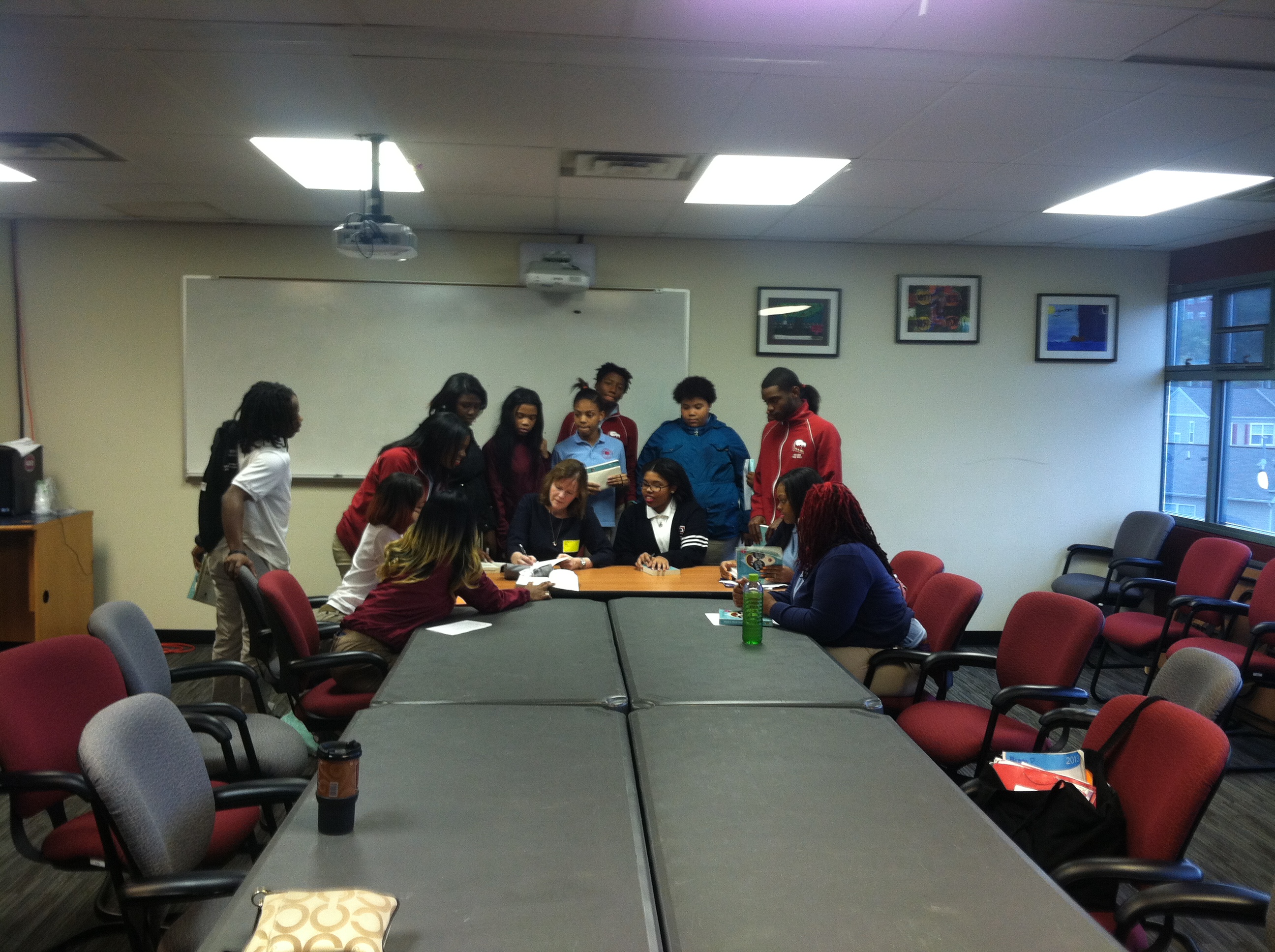When an author comes to DC to read for PEN/Faulkner, we ask if he or she would be willing to participate in Writers in Schools. We lay out the basics of the program—that we aim to serve students in public and public charter high schools by donating books, providing instructors with curricular materials, and by arranging for students to meet with authors whose work they’ve studied—and unless there’s some extenuating circumstance that prevents an author from participating, they almost always enthusiastically say yes.
It’s amazing, though, that no matter how good the program sounds in theory, in practice it nearly always exceeds expectations. Perhaps that’s merely illustrative of the differences between theory and reality; that is of course it sounds like a good idea to donate books to kids and of course it sounds like a good idea to arrange a meeting between students and the authors they’ve read for class, but just how the visit goes is often something of a mystery if the author hasn’t yet participated in Writers in Schools.

Author Tom Perrotta discusses the short stories in his collection “Nine Inches” with students at McKinley Tech.
In October, we kicked off the 2013-2014 Reading Series with an event called The Human Comedy: Serious Humor in the American Novel. The reading featured authors Tom Perrotta and Maria Semple, who packed the seats at the Folger and who participated in an engaging and entertaining discussion moderated by NPR’s Linda Holmes. In addition to the reading, both Perrotta and Semple participated in Writers in Schools for the first time. On October 22nd, Maria Semple visited the SEED School of DC where she met with 21 students who’d read her novel Where’d You Go, Bernadette? Perrotta visited another 30 students at McKinley Technology High School on October 23rd.

Author Maria Semple signs books for students at the SEED School of Washington following a long discussion of her novel “Where’d You Go, Bernadette?”
In each case, the students peppered the authors with questions about their inspiration, their writing process, their lives and—not surprisingly given each author’s particular talents—their senses of humor. For her part, Semple’s Writers in Schools visit focused largely on the details of writing an epistolary novel. Where’d You Go, Bernadette is largely composed of notes, emails, diary entries, etc. It was, according to the students, not like many other novels they’ve seen. Perrotta’s visit was wholly different, though the students also zeroed in on the structure of the book. Perrotta’s latest publication is a collection of short fiction called Nine Inches, and it provoked several specific questions about individual stories but just as central to the conversation were the questions about collections in general. How long does it take an author to put a collection together? How do you know what to include and what to leave out? Once you’ve written several stories, how do you most effectively put them in an order that makes sense to a reader? Do the stories need to be thematically linked, or can they represent a range of ideas, narratives, and writing styles?

Author Kevin Powers begins his Writers in Schools visit with a short reading from his novel “The Yellow Birds.”
In November, authors Philip Caputo and Kevin Powers travelled to Washington to participate in a reading series event that we called Blood Lines: The Literature of War. As with Semple and Perrotta, the visit represented the first time each author would participate in Writers in Schools. Caputo visited the newly renovated and recently reopened Cardozo High School while Powers met with a class at Washington Latin Public Charter School. Because Caputo and Powers both write about war (NB: both are also veterans of war), the tone of these visits was necessarily different than it’d been for Semple and Perrotta. During Kevin Powers’s visit to Washington Latin, students had many questions about the ethical guidelines of the military’s Rules of Engagement (ROE), and about the ins and outs of being a soldier.
Having accompanied Perrotta, Semple, and Powers on their Writers in Schools visits, I was struck not merely by the range of tones, topics, and craft issues that were touched on, but by the analytic depth and the rigor that students applied to their own reading. In an age of abundant forms of digital entertainment and distractions, it’s easy to feel pessimistic about the state of American readership and the future of the book. But in every visit I’ve attended this semester, the students have had such clear-eyed questions and such genuine insight that fretting over the future of the book and, more generally, of readership seems unnecessary and, well, wrongheaded.
As Writers in Schools aims to complete 170 author visits in Washington, DC this school year and another 30 visits in Baltimore as part of our expansion to that city, it’s hard not to feel excited about the future. As an arts administrator and as a reader, I can’t think of a better or more fitting way to bring 2013 to a close.
— Nate Brown
Deputy Director, PEN/Faulkner
